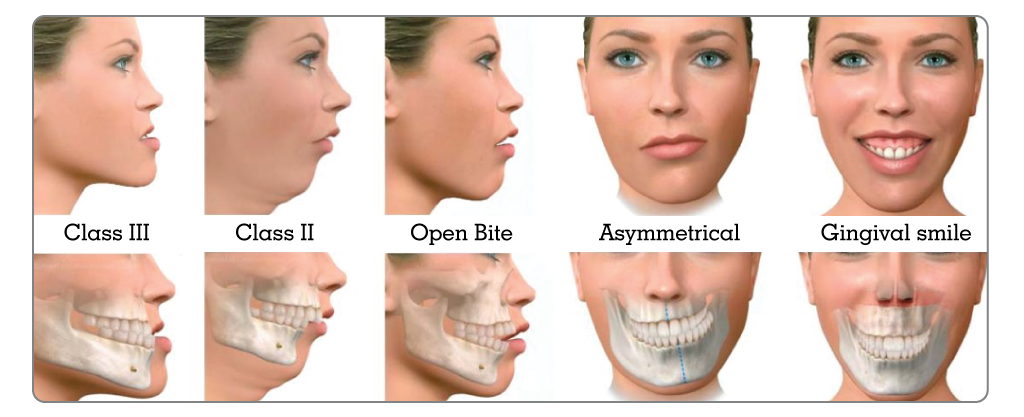
Maxillofacial Surgery
Oral & Maxillofacial surgery specializes in treating many diseases, injuries and defects in the jaws and the hard and soft tissues of the Oral (mouth).
Dental Surgery
Orthognathic Surgery:
Corrective jaw surgery (orthognathic surgery) treats and corrects abnormalities of the facial bones, specifically the jaws and the teeth. Often, these abnormalities cause difficulty associated with chewing,talking, sleeping and other routine activities. Orthognathic surgery corrects these problems and, in conjunction with orthodontic treatment, will improve the overall appearance of the facial profile.
Occlusion problems:
Many people relate the problems of occlusion only and exclusively with aesthetics. But it is not a punctual inconvenience or fashions to improve our image. It is important to be aware that the fact of not having properly fitted the teeth can . lead to tooth decay and diseases in the gums. And more things: decrease the quality of chewing is breeding ground to have digestive problems, constipation, gas or poor nutrition and deficient digestion very harmful to the health of the individual.
Aesthetics, of course, is important. Getting a beautiful smile is a mandatory task of dentists, to help improve self-esteem and make people gain quality of life, although the priority is always to combine dental health with improving the image, especially making diagnoses and follow-ups to patients from childhood, through adolescence and into adulthood.
The American Association of Orthodontists recommends that the ideal age to visit the orthodontist is at age 7, since severe problems of growth or crowding can easily be corrected before puberty is over. What is malocclusion?
Malocclusion occurs when there is an irregular contact between the teeth of the upper jaw with those of the lower jaw, that is, closing the mouth does not fit the teeth properly in the jaw and causes problems with the bite. We screw the molars up with the ones below. Generally this problem derives from an alteration of the bone growth, which prevents a correct function of the masticatory apparatus, hence the adverse consequences in our digestive system.

Types of malocclusion :
Everything depends on the patient, that is why at Coinsol we give great importance to the first visit, to diagnose and be more efficient in the treatments.
There are several types, from the most severe to the most serious:
Class I. When the jaws are well aligned but the teeth do not fit well. There may be too many large or small teeth for the whole of our jaw, which makes chewing difficult and can generate tooth decay and gum disease. Class II The upper teeth protrude with respect to the lower teeth mainly due to a retracted position of the jaw. In adult patients, if this deficiency is very large, surgery may be required. Class III It is less frequent. It responds to a bad growth of the upper jaw or an excess of growth of the jaw, which deforms the appearance of the face. If it is very serious, an orthodontic treatment with surgery is required for its correct correction.
Other common causes of occlusion problems are:
Cross bite. One or more teeth, either of the anterior teeth or of the molars, may be in an inverted relationship with its antagonist. Openbite. When the edges of the front teeth can not collide, even though the molars do contact. Deep bite. The upper teeth cover too much to the lower ones, reaching in some cases to contact the gum of the palate when chewing, inhibiting the normal growth of the jaw in young patients.
Orthodontic treatment:
Once the problem is analyzed, Coinsol proposes solutions , adapting the treatment to the needs of the patient. There are many techniques that help to resolve the malocclusion, either with removable appliances of orthodontics, when the malocclusion is mild; with fixed appliances, as well as with maxillary orthopedics, which is used especially when there are deficiencies in the skeleton of the face.
In Coinsol has developed the hand of Professor Solano multi-sequential technique (MSE) of great disclosure, which the doctor applies with great success in their patients, for the correction of all types of malformations from child to adult.
Well-aligned teeth and a proper bite allow, among other things, to avoid wear caused by premature contacts, but also prevent the accumulation of bacterial plaque responsible for caries and gum problems.
Contact Coinsol so that you have the best diagnosis and the most innovative techniques in orthodontic treatments.
Maxillary Advancement with Mandible Setback
Maxillary advancement is a type of orthognathic surgery that may be necessary to improve the facial contour and normalize dental occlusion when there is a relative deficiency of the midface region. This is done by surgically moving the maxilla with sophisticated bone mobilization techniques and fixing it securely into place.
For most patients, the use of screws and miniplates have replaced wiring of the bone and teeth required to hold the jaw stable. Inlay bone grafts can be utilized for space maintenance and secured with screw and plate fixation, while onlay bone grafting is used to augment the bony skeleton and improve facial soft tissue contour.
Wisdom Tooth
Third molar teeth (commonly referred to as wisdom teeth) consist of the mandibular and maxillary third molars; they usually appear between the ages of 17 and 25. They are called wisdom teeth because usually they come in when a person is between age 17 and 25 or older—old enough to have supposedly gained some wisdom.
Wisdom teeth are commonly extracted when they affect other teeth—this impaction is colloquially known as "coming in sideways." Most adults have four wisdom teeth, but it is possible to have more or fewer. Absence of one or more wisdom teeth is an example of hypodontia. Any extra teeth are referred to as supernumerary teeth.


 Cosmetic Periodontal Surgery
Cosmetic Periodontal Surgery